- Home
- Trevor Hoyle
Earth Cult Page 13
Earth Cult Read online
Page 13
‘You bend over backwards to be fair, don’t you, Frank?’ Helen said in a tone that was more accusing than complimentary.
‘I don’t want to be responsible for wholesale panic in this town. Imagine what the Telluric Faith would make of this if they got to hear about it. Let’s at least give Friedmann the opportunity to put forward his side of the story.’ He added meaningfully, ‘The press does have a responsibility not to alarm the populace unnecessarily.’
‘Which shouldn’t outweigh its responsibility to publish the truth,’ Helen retorted. She ducked back in the car and kissed him on the mouth.
‘Is that a bribe?’ he asked her.
‘In lieu of services yet to be rendered.’
‘I’ll add it to your account.’
‘It’ll be paid in full,’ she promised him, and skipped across the sidewalk into the office.
He drove along the main street and parked outside the Cascade Hotel. Again he was struck by the normality of everything: it didn’t seem feasible that beneath the fabric of this quiet, orderly, ostensibly peaceful community there should lurk the paranoia of religious fanaticism. And yet, as Frank had to admit to himself, it was no less incredible than what had been happening at the Deep Hole Project – men who died of brain tumours caused by radiation, scientists who disappeared without warning or who were suddenly transformed into violent raving madmen. All of this had to fit together somehow; all these events formed a pattern that either he was too ignorant to understand or too dense to see.
As for black vibrating objects which had the power to transport human beings through 150 feet of solid rock… he preferred to suspend his rational faculties for the time being and postpone final judgment. There were quite a few things not dreamt of in his philosophy, Frank realized, and he wasn’t going to compound ignorance with rank stupidity.
Part of the square was flooded from a burst main, the aftermath of the previous night’s tremor, and a gang of workmen was hard at work in a trench, lowering new sections of pipe into position.
Frank went through into the lobby. Spencer Tutt was behind the desk, propped on his elbows in his usual posture of lackadaisical indifference, his lean chest and jutting shoulders as spare as a scarecrow’s. With what seemed great and wearisome effort he raised himself upright and reached behind him into a pigeon-hole.
‘Cable arrived for you, Mr Kersh. ‘Bout half hour ago. Didn’t know where you could be reached.’
Frank took it, nodding his thanks. He said, ‘Can I get something to eat around here?’
Spencer Tutt sucked on a tooth and shook his head. ‘Dining-room won’t be open till tonight. There’s a coffee shop along the street. Get a meal there or a sandwich. They stay open all day.’
Frank turned away and Spencer Tutt went on, ‘Are you plannin’ to stay on here, Mr Kersh? I’m only askin’, you understand, ‘cos Walt Stringer was wonderin’. He asked me to ask you.’
‘At twenty dollars a night I’d have thought he’d be glad of all the custom he can get.’
Spencer Tutt shrugged lazily. ‘I’m only doing what he told me.’
‘Tell Mr Stringer from me that when I’m ready to leave I’ll let him know.’ He smiled without using his eyes. ‘All right?’
‘Sure ‘nough, Mr Kersh. I’ll tell him that.’
Frank went along the street to the coffee shop and sat in a corner booth, ordering Chicken Maryland with a side salad, fruit salad and cream, and black coffee. While he waited for it to be served he opened the cable, lit a cigarette, and concentrated on what Fred Lockyer had to tell him about the latest theoretic research data on neutrinos. When the meal arrived he had read it through once and was about to read it again; Fred Lockyer must have thought it important enough not to economize on the telegram charge, nor to spare the smallest detail. It was all here, in terse technical shorthand that stretched Frank Kersh’s knowledge of high-energy particle physics to the utmost. But he grasped the basic essentials, and those were precisely what he needed to know to complete the picture.
It was a picture at once simple and complex: the simplicity lay in the lucid theoretical reasoning while the difficulty arose out of the failure of the everyday imagination to visualize events on a subnuclear scale. The layman’s conception of atomic structure was, needless to say, erroneous. Most people still thought of the atom as being comprised of a series of billiard balls circling round the nucleus, much as the planets of the solar system orbit the Sun. It was a model which led to a host of false assumptions, not to mention the layman’s confusion in failing to understand that the atomic nucleus was, by definition, incapable of being visualized at all in terms that the human mind could comprehend. It was on such a vastly different scale to that which human beings were used to that it was literally impossible to construct a model by employing objects and artefacts within common experience. Therein lay the difficulty – the ultimate conceptual unknowableness of what constituted the stuff of matter and energy.
The theoretical structure, on the other hand, was capable of being understood by anyone with a scientifically-trained mind who was used to dealing with abstract mathematical symbolism and visualizing concepts in terms of pure logic and deductive reasoning.
The cable spelt it out:
Recent experiments at Fermilab near Chicago had produced surprising and totally unexpected results. The scientists had fired a barrage of neutrinos at a 400-ton block of steel and the ensuing interaction had brought forth a shower of hadrons which had been absorbed by the surrounding material. So far so good: just what current theory predicted would happen. Then out of the energy created by the collision came three long-range particles known as muons – which not only hadn’t been predicted but for which there was no tenable explanation. It had been known for some time that neutrinos decayed into muons upon interaction with other particles, but to have produced three of them from a single neutrino was, to say the least, puzzling.
These events – the generation of three simultaneous particles from the one interaction – had been dubbed trimuons, and even now the theoreticians were busily engaged in trying to formulate a new hypothesis of nuclear generation to account for them.
This information in itself was interesting but not particularly enlightening with regard to the experiments being carried out at the Deep Hole Project. If trimuon events had been detected by Friedmann’s team there was no reason to suppose they would be any more harmful than those generated artificially at Fermilab.
It was the second part of the cable, dealing with the antiparticle equivalents of neutrinos, that cleared away the fog and for the first time gave Frank Kersh a real insight into what had been taking place at the bottom of the Telluride Mine. Fred Lockyer was here entering the realms of speculative prediction, but nonetheless his assumptions were still firmly based on the premises which had been established for many years and accepted by high energy physicists the world over.
He postulated what would happen if the neutrino-in-muon interaction was interpreted as an antineutrino-antitrimuon event. That was all. He simply transferred the same theoretical framework as it applied to the ordinary world of matter to the extraordinary world of anti-matter. His conclusion was that a stream of antineutrinos travelling at the speed of light would, upon hitting the target, decay into antitrimuons and produce vast amounts of energy which would be released in the form of radiation. This of course had never been attempted in the laboratory for the simple reason that it was a highly dangerous experiment and would generate enough lethal radiation to contaminate not only the laboratory but the surrounding countryside for a radius of a hundred miles.
His concluding thought was one of cheerful reassurance to the effect that antineutrinos didn’t exist in nature in sufficient numbers to pose a threat to the Earth. Neutrinos outnumbered them by ‘a trillion to one’ and he had worked it out mathematically that under normal circumstances an antineutrino-antitrimuon interaction would occur only once in every ten thousand events. Since antineutrinos were comparatively rar
e, and the rate of interaction so small, there was absolutely no chance that any significant amount of radiation would be generated by the stray antineutrino which happened to collide with a suitable target and decay into an antitrimuon. The odds against this happening were, as he put it, ‘infinitesimal’.
But then Fred Lockyer wasn’t aware that for the past two years the Solar Neutrino Detection Station near Gypsum, Colorado had been detecting a 200-fold increase in antineutrinos reaching the Earth from the centre of the Galaxy.
And what was even more critical, as Frank now realized, was the fact that the local geophysical strata was ideally suited to producing antineutrino-antitrimuon interactions: the Mount of the Holy Cross was composed largely of tellurous ore which made it in effect a 14,000-feet-thick target area for the antineutrinos flooding in from outer space. It was nature’s equivalent of Fermilab’s 400-ton block of steel – only a million times bigger. Add to that the mile-deep strata beneath and you had the most perfect conditions imaginable for antineutrino -antitrimuon decay – producing vast floods of radiation which without doubt had been responsible for the deaths of the four scientists.
And much else besides.
The Chicken Maryland had cooled and finally congealed on the plate. He had chain-smoked three cigarettes in under ten minutes and had read and re-read the cable so many times he knew it off by heart.
Had he at last found the answer to what had been causing the mysterious chain of circumstances along the Roaring Fork Valley? The more he thought about it, the more plausible it became:
Severe atmospheric turbulence.
Freak thunderstorms.
Earth tremors.
Scientists killed by radiation.
Irrational behaviour by the Project leader and his assistant.
The Telluric Faith – question-mark.
The babies in the hospital – two question-marks.
He reviewed the list in his head and decided that five out of the seven could be traced directly back to the antineutrino-antitrimuon theory. Of the Telluric Faith he was less certain – unless it was possible that the radiation had affected the townspeople and made them behave in such a bizarre fashion.
And why the babies should emit radiation completely baffled him. True, it was only a small amount, not enough to be harmful either to themselves or to anyone who came into contact with them, but why should they be affected in this way at all? Some children had been born perfectly normal while others exhibited this strange behaviour pattern. Why? Was it accidental, a random side-effect of the radiation which had leaked out of the mine and been genetically transferred from the mothers to their offspring?
He had solved one part of the conundrum only to be faced with other, deeper, more complex problems. Amongst them was the disturbing thought that if this was happening in Gypsum it was almost certainly happening elsewhere in the world. There must be other strata whose mineral composition would make them ideal target areas for antineutrino-antitrimuon interaction. And if this same phenomenon was taking place on a global scale it gave rise to the chilling possibility that various parts of the Earth’s surface were being subjected to a form of intense interstellar radiation that was affecting the genetic structure of newborn babies.
Frank lit another cigarette and tried hard to recall all that he knew about anti-matter and its place in the Universe. Of course particles of anti-matter were by no means a new phenomenon – they had been detected many years ago and their physical reality validated by countless experiments. Some scientists believed anti-matter to be comparatively rare in the Universe, and it was indeed true that observation showed the abundance of matter to far outweigh its antimatter equivalent. But there was another theory that everything in nature was finely balanced – left-hand and right-hand, action and reaction, positive and negative, plus value and minus value – and some argued that if the balance were to be maintained it was only logical to suppose that for every particle of matter there was an equivalent particle of anti-matter.
In other words, there had to exist an Anti-Matter Universe.
Presumably in such a place everything would be reversed: the Anti-Matter Sun would produce antineutrinos instead of neutrinos, natural radio-activity would produce neutrinos instead of antineutrinos. The status quo would be maintained. But what if – as now seemed to be happening – there was a spectacular increase in anti-matter and rather than being a rare occurrence in the Universe particles of antimatter were challenging particles of matter for supremacy? It was rather a dramatic way in which to view the situation, almost as if the Anti-Matter Universe were seeking to overcome the Universe as it presently existed. But the fact had to be faced that Friedmann’s experiments had detected a vastly increased emission of anti-matter from the region of Sagittarius A in the heart of the Milky Way Galaxy, and if such results were found to be true it could only mean that the Universe and the Anti-Matter Universe were in the throes of some colossal cosmic confrontation.
Was it accidental, Frank wondered, the forces of nature (and presumably anti-nature) locked in a blind meaningless struggle for dominance, the law of survival enacted on a super-galactic scale? Or was there somewhere in the cosmos an Intelligence controlling and directing the influx of antimatter into the Universe, following a plan that was so vast and incredibly complex as to be beyond the conception of the species of life which crawled upon the face of the Earth?
… and of every creeping thing that creepeth upon the earth.
Frank recalled the Biblical phrase quoted by Cabel. It now seemed that the preacher – without knowing it – had stumbled on something approaching the truth: he had founded a religion which believed the Mount of the Holy Cross to be alive, which saw the Earth as a sentient being, and in the sense that deep within the mountain nuclear interactions were taking place he was correct in his belief. The mountain was alive in that it was generating vast amounts of radiation. The Earth itself was receiving particles of anti-matter from the centre of the Galaxy which were affecting and changing is geophysical structure; Cabel’s religious inspiration could be verified and upheld by hard scientific fact.
The waitress removed the untouched meal, shaking her head at the waste and the weird habits of some of the customers. Frank awoke from his reveries and for no sensible reason looked at his watch. He had the feeling that time was pressing, that he ought to be doing something, taking some sort of action, but what action could he take? If his reasoning was correct and his conclusions valid, what could he or anyone do to change things?
It came to him, like a sudden wrench in the heart, that he was the only one in possession of all the facts. Fred Lockyer had one piece of the jigsaw concerning the antineutrino-antitrimuon interaction, and Professor Friedmann had the data pertaining to the increase in antineutrinos emanating from the galactic centre; but only Frank Kersh knew how the two sets of information related to each other. He was the link between them, possibly the only living person who had so far managed to piece together a series of apparently unconnected events – the latest observational findings on antineutrinos, and current theoretical thinking on the nature of matter/anti-matter particle interaction.
Perhaps the chain of reasoning was faulty in some respect? Couldn’t it be argued that Fred Lockyer’s speculative assumptions were based not on proven experimental evidence but on abstract theory? High energy physicists were not infallible godlike creatures; they had been known to make false predictions in the past and it was well within the bounds of probability that once again they were trying to theoretically run before they could experimentally walk. It was a faint hope, but the only glimmer of light that Frank could see. He himself wasn’t capable of working through Fred Lockyer’s hypothesis, of checking it out in step-by-step detail in order to confirm or deny its validity; only an experienced theoretician could do that.
And what if he was correct? What if it were true that at the centre of the Galaxy, in the region of Sagittarius A, a new and unknown and incredibly powerful source of energy was beaming p
articles of anti-matter towards the Earth which would interact to produce high-level radiation?
The question in Frank Kersh’s mind was not to ask if and how this was possible: the question was, in heaven’s name why?
SEVEN
Cal Renfield was putting the paper to bed, crooning and cursing over it alternately as he came across a piece he liked followed by an item which met with his displeasure. He was stooping over the large oval desk, his shirt-sleeves rolled back to reveal freckled, almost hairless arms, reaching without looking for a cigarette which smouldered in the ashtray.
Helen was at the back of the office, mounting photographs on sections of card, the rich red tint of her hair in severe contrast to the pale delicacy of her features, the fine cheekbones and calm grey eyes. She glanced up as Frank came in but carried on with her work, her movements methodical and practised, swift and yet unhurried. She said without looking up:
‘The staff of the Roaring Fork Bulletin swing into action to produce yet another issue packed with hard-hitting facts and shattering exposés which lift the lid off the vice and corruption rampant amongst Gypsum’s business and political élite. Whose head will roll tomorrow? Which highly placed politician will pick up his morning paper with trembling hands and see his doom written in the stark black headlines?’
‘It’s a nasty business,’ Frank said.
‘What is?’ Cal Renfield inquired absently.
‘Packing horse manure into plastic bags.’
Cal Renfield grunted, his pencil moving at speed down the copy, initialling each page and racing on to the next.
Helen brought a stack of mounted photographs to the desk, sorted them into the correct order and marked each one with a felt-tip pen. She said, ‘How about that – my five-legged calf gets the front page spot. When you make it in this town you really make it.’

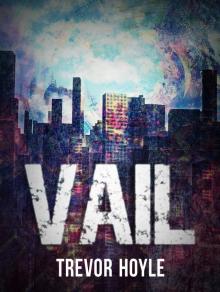 Vail
Vail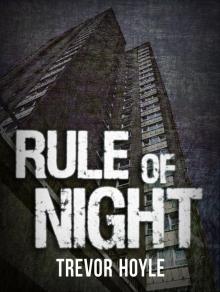 Rule of Night
Rule of Night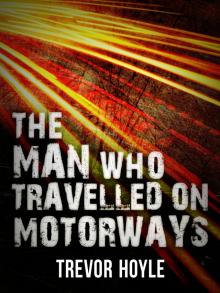 The Man Who Travelled on Motorways
The Man Who Travelled on Motorways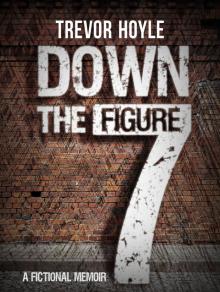 Down the Figure 7
Down the Figure 7 The Gods Look Down
The Gods Look Down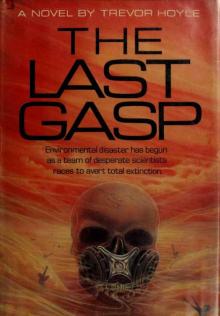 Last Gasp
Last Gasp Mirrorman
Mirrorman Seeking the Mythical Future
Seeking the Mythical Future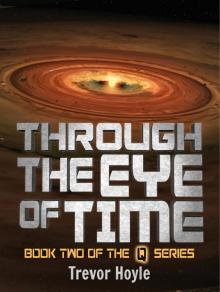 Through the Eye of Time
Through the Eye of Time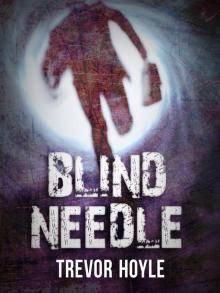 Blind Needle
Blind Needle Earth Cult
Earth Cult